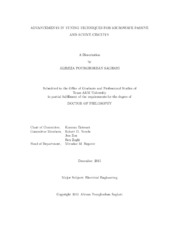| dc.contributor.advisor | Entesari, Kamran | |
| dc.creator | Pourghorban Saghati, Alireza | |
| dc.date.accessioned | 2016-05-04T13:19:18Z | |
| dc.date.available | 2017-12-01T06:36:15Z | |
| dc.date.created | 2015-12 | |
| dc.date.issued | 2015-08-24 | |
| dc.date.submitted | December 2015 | |
| dc.identifier.uri | https://hdl.handle.net/1969.1/156378 | |
| dc.description.abstract | Due to the rapid development of wireless systems, the demand for communication devices that can operate in different bands is increased. The passive solution, as a result, can be one of the multiple-frequency, wideband, or reconfigurable/tunable choices. It is true that multi-frequency structures have the advantage of serving multiple frequencies at the same time, but the crosstalk from neighbor bands makes them a weak choice in comparison to tunable/reconfigurable devices. Unlike multiple/wide band microwave devices, tunable structures offer better isolation. Moreover, covering multiple bands should not decrease the selectivity and Q of the device, which is not a true statement for multi-frequency structures.
The major focus of this dissertation was to address key issues in designing tunable microwave devices. Different tunable microwave structures, specifically antennas, using mainly two methods are presented. The first method is based on loading substrate integrated waveguide (SIW) cavities with via posts and then connecting them to switching devices. Three antenna designs and one SIW-based VCO is designed and implemented based on the proposed technique. The tuning technique is first developed using a conventional SIW cavity backed antenna to achieve an octave tunable antenna with ~65% of miniaturization. For the second and third antennas the method is applied to SIW antennas along with different miniaturization methods that result in tunable directive antennas with more than 80% of miniaturization.
The second method is a different technique, which is based on loading the microwave devices and antennas with non-toxic liquid metal materials. While the first SIW-based approach offers wide tuning range with high quality factor/efficiency, the latter makes it possible to avoid using lossy and power consuming switches or varactor diodes. Using the second technique, tunable microwave filters and antennas that are suitable for high-power applications are proposed. A major part of this work also dealt with measurement techniques to prove the suitability of microuidic-based tuning techniques for high-power applications. | en |
| dc.format.mimetype | application/pdf | |
| dc.language.iso | en | |
| dc.subject | SIW tunable devices | en |
| dc.subject | microfluidics microwave tuning | en |
| dc.title | Advancements in Tuning Techniques for Microwave Passive and Active Circuits | en |
| dc.type | Thesis | en |
| thesis.degree.department | Electrical and Computer Engineering | en |
| thesis.degree.discipline | Electrical Engineering | en |
| thesis.degree.grantor | Texas A & M University | en |
| thesis.degree.name | Doctor of Philosophy | en |
| thesis.degree.level | Doctoral | en |
| dc.contributor.committeeMember | Nevels, Robert D | |
| dc.contributor.committeeMember | Zou, Jun | |
| dc.contributor.committeeMember | Zoghi, Behbood B | |
| dc.type.material | text | en |
| dc.date.updated | 2016-05-04T13:19:18Z | |
| local.embargo.terms | 2017-12-01 | |
| local.etdauthor.orcid | 0000-0001-6132-2132 | |


